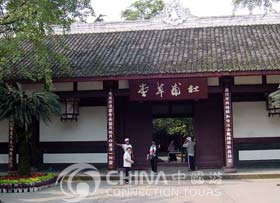
 The thatched cottage of the famous Tang dynasty poet Du Fu (712-770AD) lies at the side of the Flower Washing Brook in west Chengdu.
The thatched cottage of the famous Tang dynasty poet Du Fu (712-770AD) lies at the side of the Flower Washing Brook in west Chengdu.
Du Fu (AD 712-770) lived in a period when the Tang Dynasty (AD 618-907), one of China's most flourishing dynasties, began a slide into decline. Seeking refuge from the rebellion war, Du was forced to move to Chengdu. With the aid of friends, he built a thatched cottage by the Flower Bathing Brook and settled here for 4 peaceful years. It was here that he wrote 240 of his 1400 poems. Once, a storm destroyed the roof of the thatched cottage. This led to the writing of one of his masterpieces, "the Song of Autumn Winds Destroying My Cottage". In this poem, he expressed his anxiety for the plight of other poverty-stricken scholars and the desire for shelter for all the poor.
After Du Fu's death, people built a new cottage on the ruins of the original site, as a memorial to Du. Today the Thatched Cottage, which covers 20 hectares of leafy bamboo and luxuriant vegetation, has become a commemorative  museum in the form of a traditional garden. The area contains several interesting structures, including the grand lobby, the Shrine of Gong Bu (Du's official title) and the Memorial Hall of Du Fu. In the grand lobby stand two antique wooden screens. One bears a brief account of Du's life and the other, a traditional Chinese painting of Du's cottage. Inside the Shrine of Gong Bu are stone tablets of the Ming (AD 1368-1644) and Qing (AD 1644-1911) dynasties. Du's poems have been translated into 15 foreign languages and are on display in the Memorial Hall of Du Fu. The complex also contains three imposing statues of some of China's greatest poets: Du Fu, Li You and Huang Tingjian (the latter two were Song dynasty poets).
museum in the form of a traditional garden. The area contains several interesting structures, including the grand lobby, the Shrine of Gong Bu (Du's official title) and the Memorial Hall of Du Fu. In the grand lobby stand two antique wooden screens. One bears a brief account of Du's life and the other, a traditional Chinese painting of Du's cottage. Inside the Shrine of Gong Bu are stone tablets of the Ming (AD 1368-1644) and Qing (AD 1644-1911) dynasties. Du's poems have been translated into 15 foreign languages and are on display in the Memorial Hall of Du Fu. The complex also contains three imposing statues of some of China's greatest poets: Du Fu, Li You and Huang Tingjian (the latter two were Song dynasty poets).
Each year, on the seventh day of lunar January, local scholars and poets get together in the cottage to honor Du Fu. They celebrate his works by chanting his poems to the accompaniment of dances and music.

